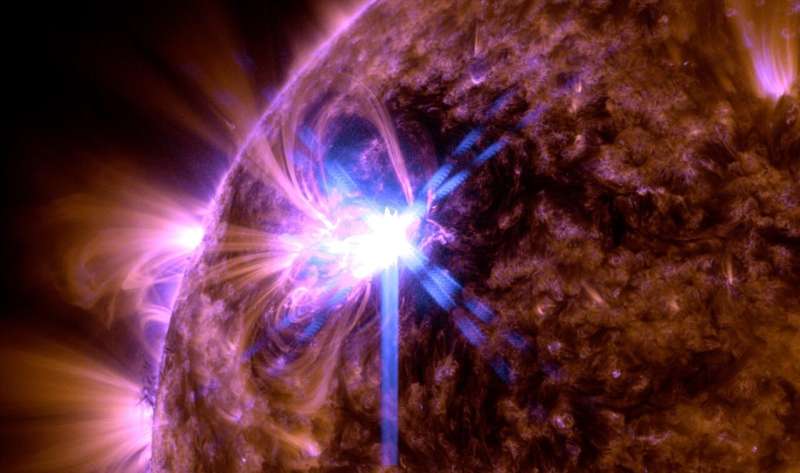NASA’s Solar Dynamics Observatory captured this image of a solar flare on February 21, 2024, as shown by the bright flash in the upper left corner. Subsets of extreme ultraviolet light are found in extremely hot materials in the corona and in flares, respectively. Cut to highlight the flared area. Image source: NASA/SDO
Although observatories such as the Kepler Space Telescope and the Transiting Exoplanet Survey Satellite (TESS) are primarily designed to search for exoplanets, they have provided a wealth of data on stellar flares through broadband filters in the visible spectrum. The light sheet is detected through high-precision photometry.
The stars are so far away that they appear only as points of light in these telescopes, and the phenomena explained as stellar flares are sudden increases in the brightness of these points.
Data are also lacking in other parts of the electromagnetic spectrum, and most studies of these events have focused on irradiated energy. Observations have discovered “superflares,” giant magnetic eruptions in a star’s atmosphere that are 100 to 10,000 times more energetic than the most energetic solar flares. The question is whether existing models can explain such high energy levels.
There are two models to choose from. The more popular one views the superflare’s radiation as blackbody emission at a temperature of 10,000 Kelvin. Another linked this phenomenon to the process of ionization and recombination of hydrogen atoms.
A study by researchers from the Mackenzie Center for Radio Astronomy and Astrophysics (CRAAM) at the University of Mackenzie Presbyterian (UPM) in Brazil and the School of Physics and Astronomy at the University of Glasgow in the UK analyzed both models.
The study was published in Royal Astronomical Society monthly notices.
“Taking into account the known energy transfer processes in flares, we believe that the hydrogen recombination model is a more physically reasonable explanation of the origin of the broadband optical emission of flares than the blackbody model,” said Paulo Simões, first author and researcher on the article. Professor at Ouhuichuan University.
The researchers used these two models to analyze 37 superflares on the binary star system Kepler-411 and 5 superflares on the star Kepler-396. “We conclude that estimates of total flare energy based on the hydrogen recombination model are approximately an order of magnitude lower than values obtained using blackbody radiation models and better fit known flare processes,” Simmons said.
These processes are described in terms of solar flares. Despite their many differences, solar flares still inform models that explain stellar flares. Much of the information about solar flares was first recorded in astronomical literature by two British astronomers, Richard Carrington and Richard Hodgson, who independently observed the same solar flare on September 1, 1859.
“Since then, solar flares have been observed with intense brightness lasting from seconds to hours and with different wavelengths, from radio waves and visible light to ultraviolet and X-rays. Solar flares are one of the most active phenomena in the solar system. One, can affect satellites to name just a few,” said Dr. Alexandre Araújo. CRAAM candidate, school teacher, and co-author of this article.
Solar flares occur in active regions associated with strong magnetic fields. Through the reconnection of magnetic fields, large amounts of energy are suddenly released in the corona (the outermost layer of the Sun), heating the plasma and accelerating electrons and ions and other particles.
“Because of their small mass, electrons can be accelerated to a large fraction of the speed of light, usually about 30% but sometimes higher. The accelerated particles travel along magnetic field lines, and some are ejected into interplanetary space, while others then in the opposite direction into the chromosphere, the layer beneath the corona, where they collide with high-density plasma and their energy is transferred into the medium.
“The excess energy heats the localized plasma, causing the atoms to ionize and excite, producing radiation that we can detect with telescopes on the Earth’s surface and in space,” Simmons explained.
Since the 1960s, many observational and theoretical studies have attempted to explain the unusually large amounts of visible light emitted by solar flares, but no clear solution has been found so far. The most popular explanations derived from these studies are blackbody radiation produced by heating of the photosphere (the layer below the chromosphere), and hydrogen recombination radiation in the chromosphere. This recombination occurs when protons and electrons separated by ionization recombine to form hydrogen atoms.
“The limitation in the first case can be summarized as an energy transfer problem: None of the energy transfer mechanisms commonly accepted for solar flares are capable of providing the energy required in the photosphere to induce sufficient plasma heating to explain the observations,” Simmons said. .
Araujo agreed, saying: “Calculations originally performed in the 1970s and later confirmed through computer simulations showed that most electrons accelerated in solar flares failed to pass through the chromosphere and enter the photosphere. .The blackbody model’s explanation of white light in solar flares is therefore incompatible with the primary energy transfer processes that solar flares undergo.
As for the hydrogen recombination radiation model, which is more consistent from a physical point of view but unfortunately cannot yet be confirmed by observations, the researchers conclude that although the article provides additional arguments in support of this model, this model is not valid in most cases. have been ignored in research.
More information:
Paulo JA Simes et al., Hydrogen recombination continuum as a radiation model for stellar optical flares, Royal Astronomical Society monthly notices (2024). DOI: 10.1093/mnras/stae186
citation: Hydrogen recombination found to be the most reasonable explanation for the high energy of stellar superflares (2024, April 15), retrieved April 19, 2024, from https://phys.org/news/2024-04-Hydrogen-recombination -plausible-explanation-high.html
This document is protected by copyright. No part may be reproduced without written permission except in the interests of fair dealing for private study or research purposes. Content is for reference only.
#Hydrogen #recombination #reasonable #explanation #high #energy #stellar #superflares
Image Source : phys.org
